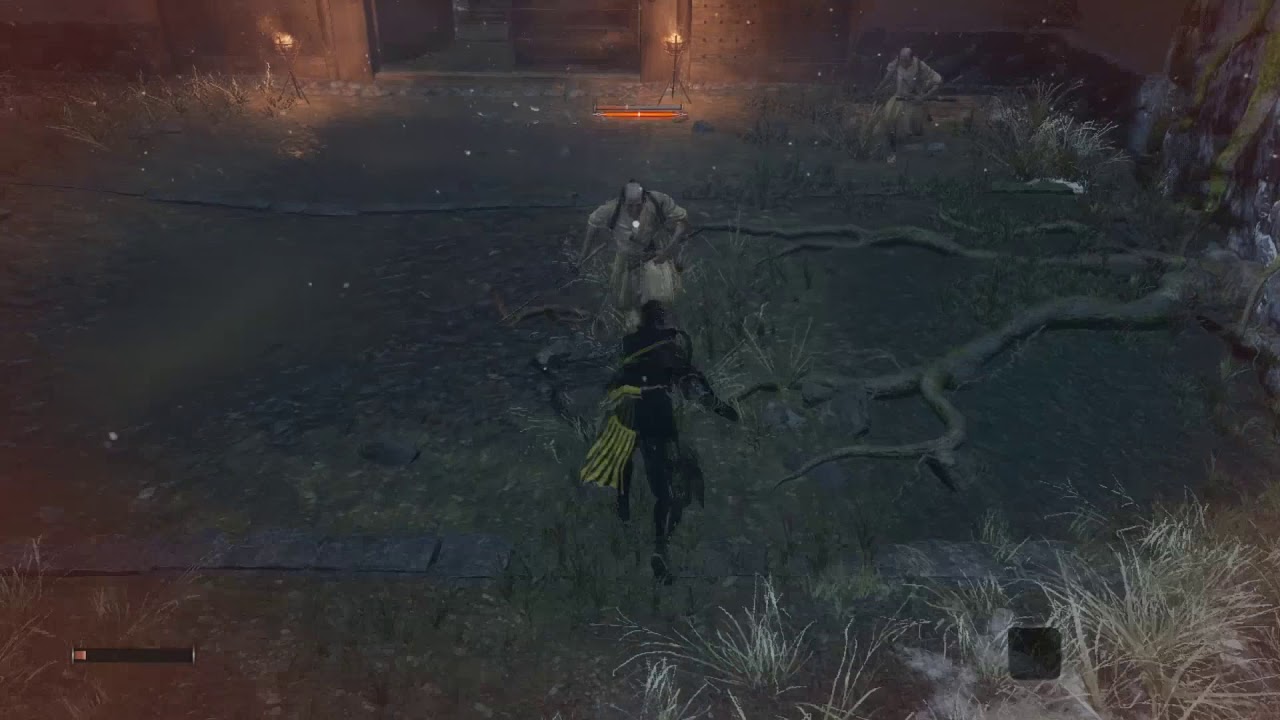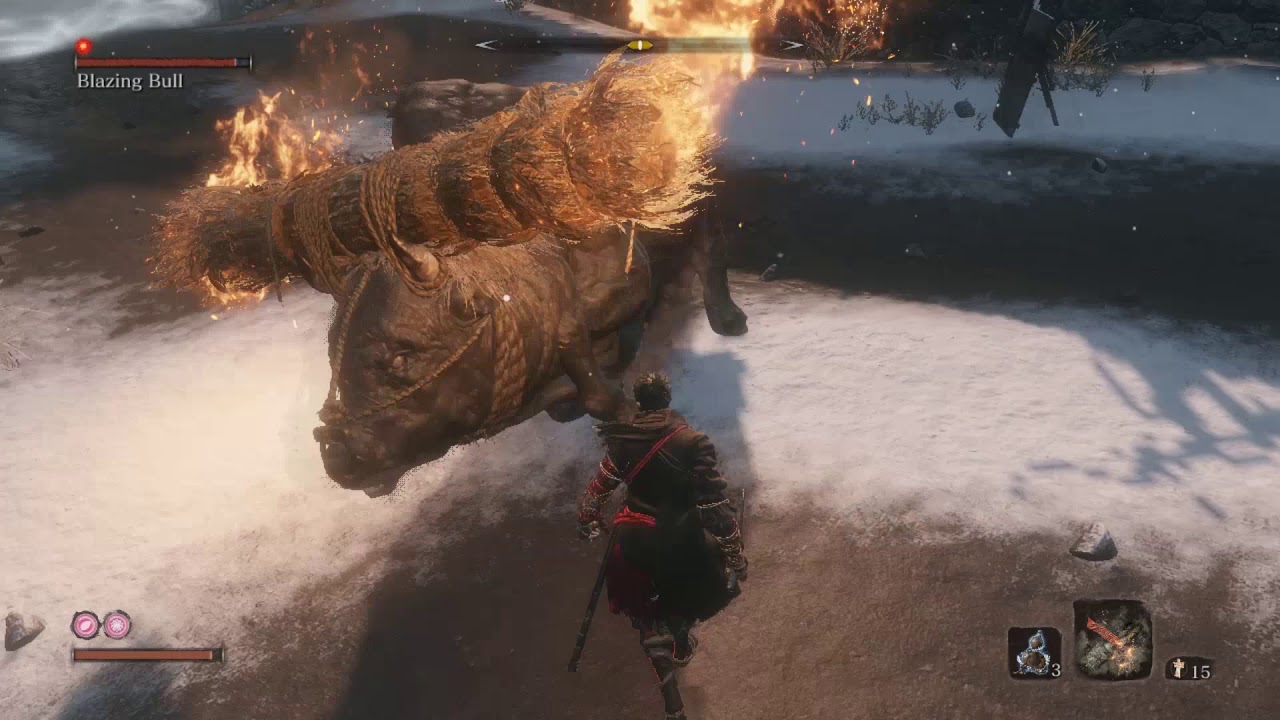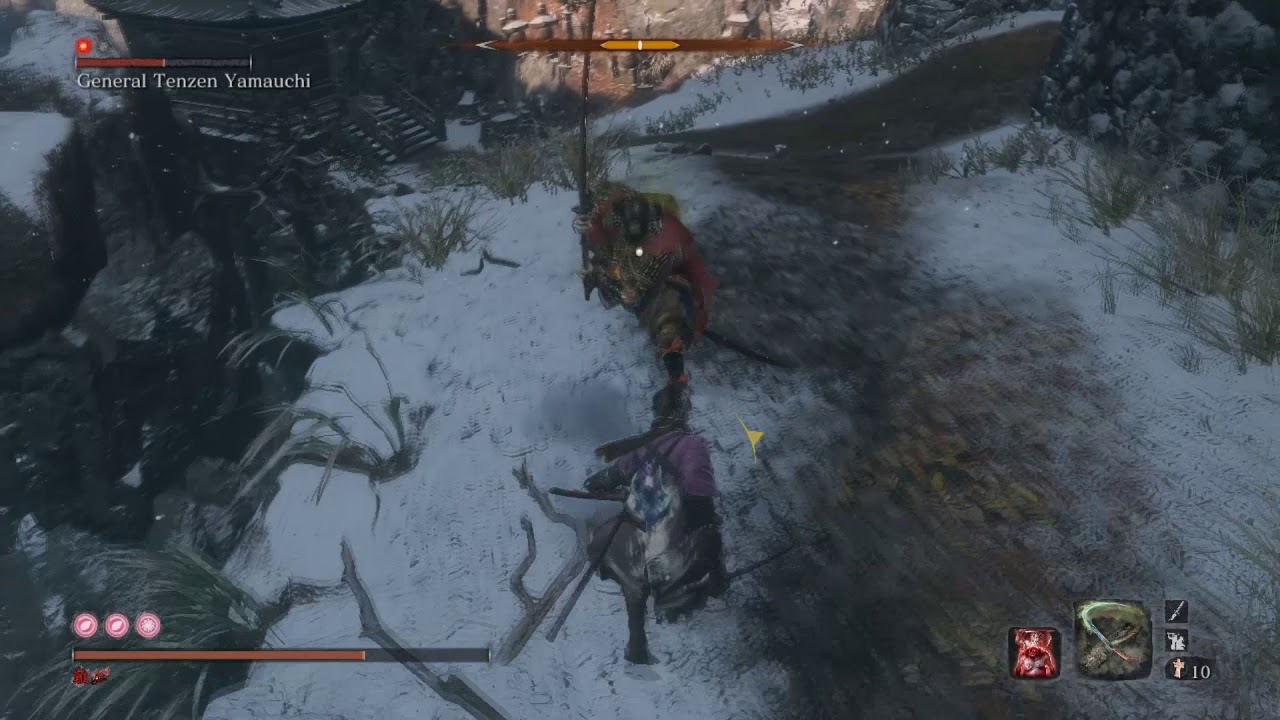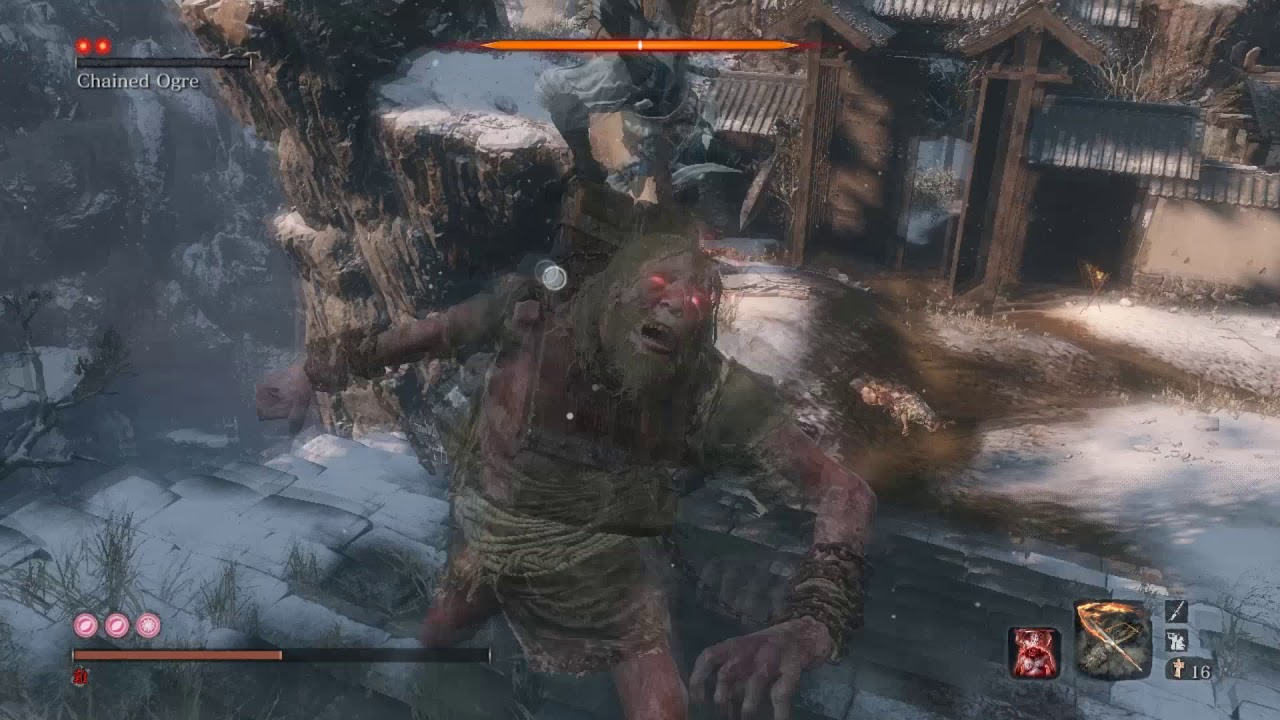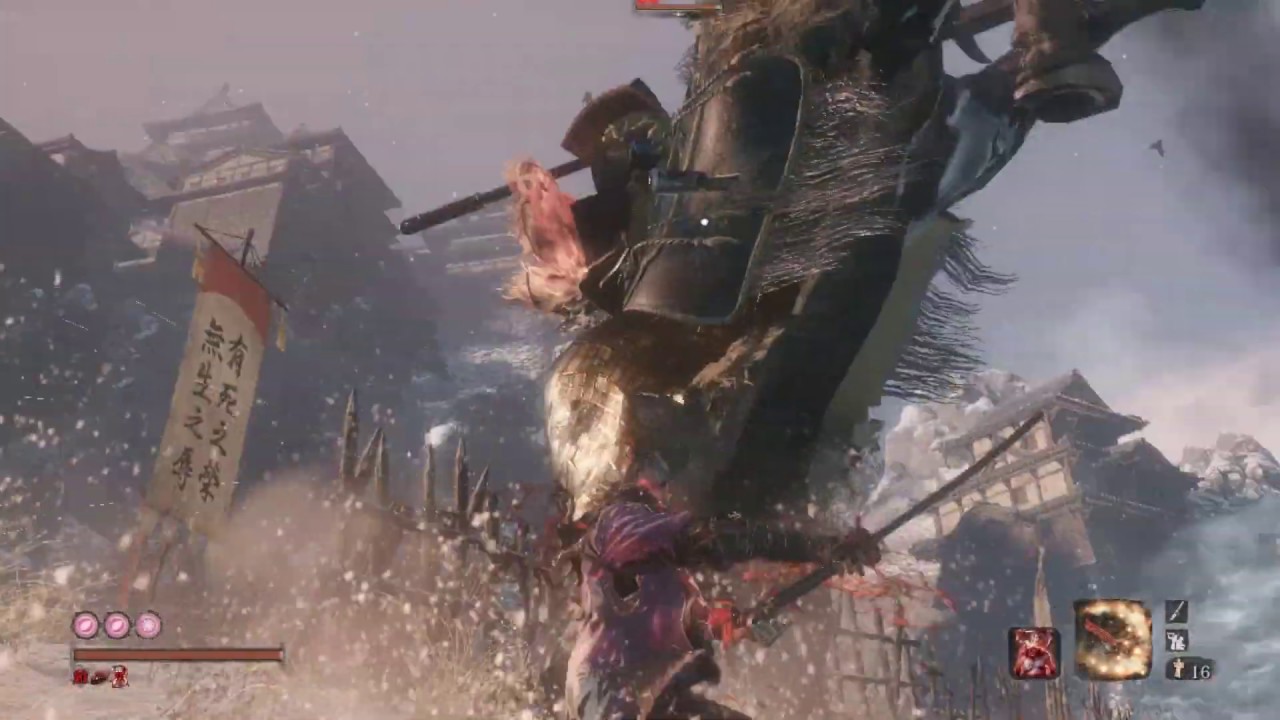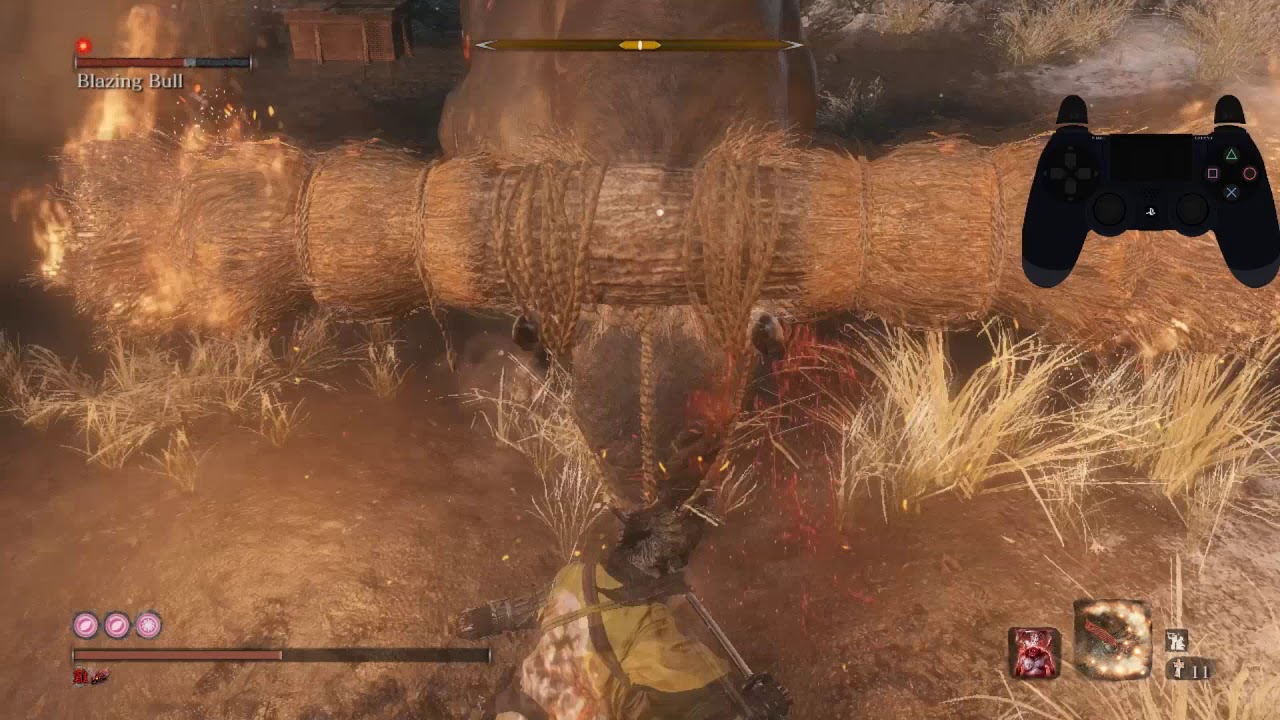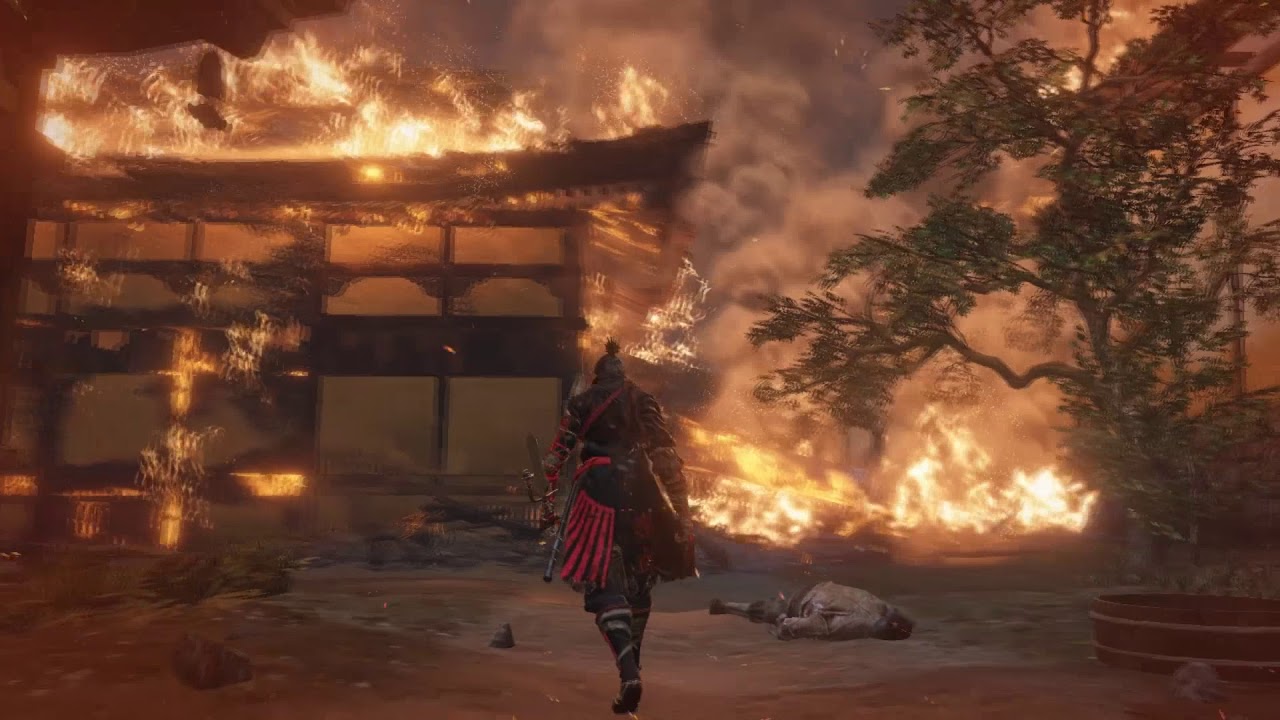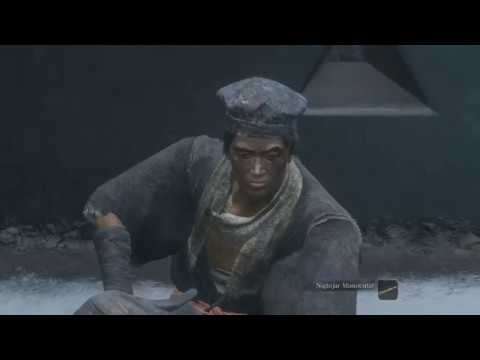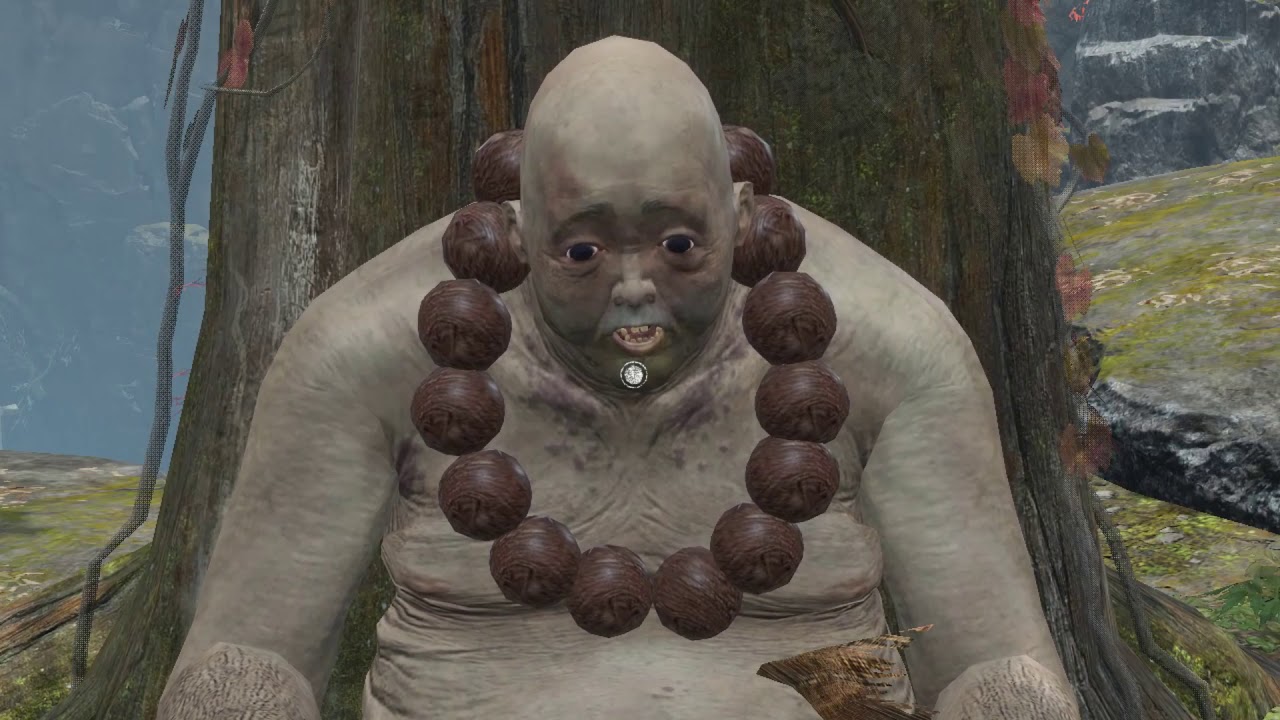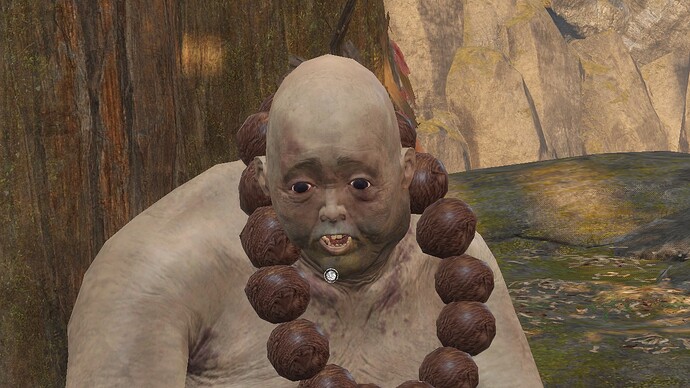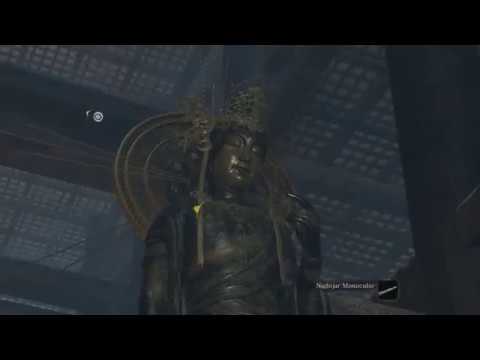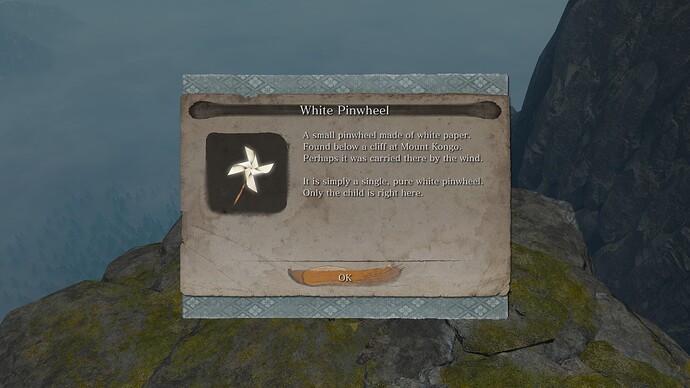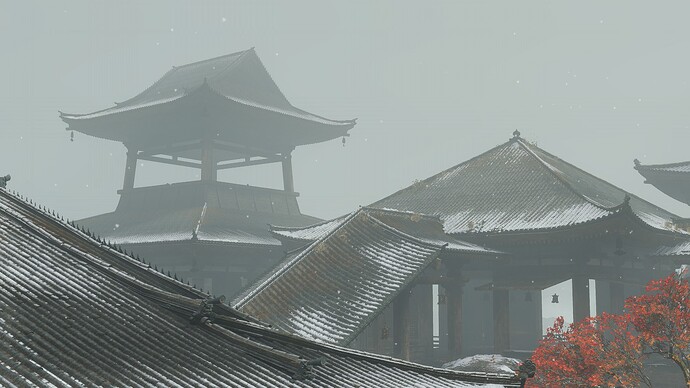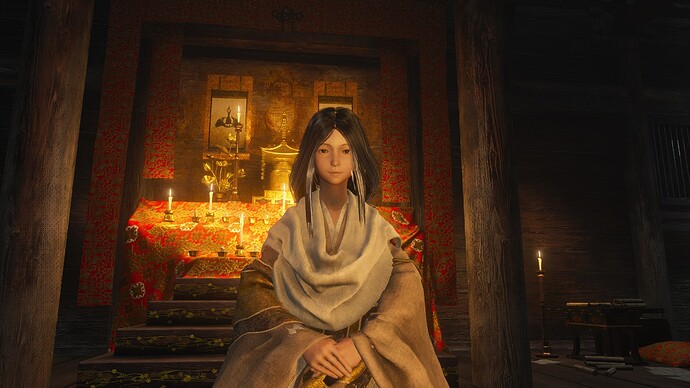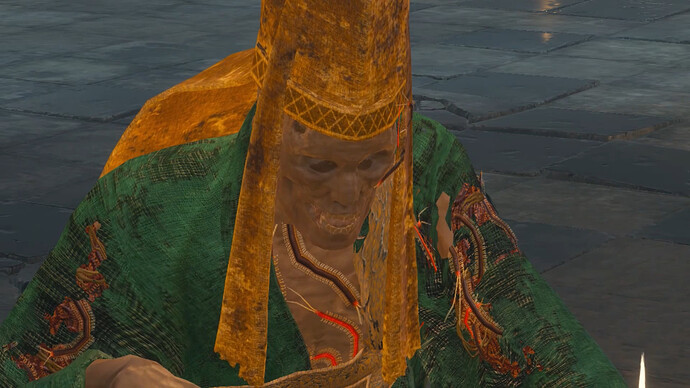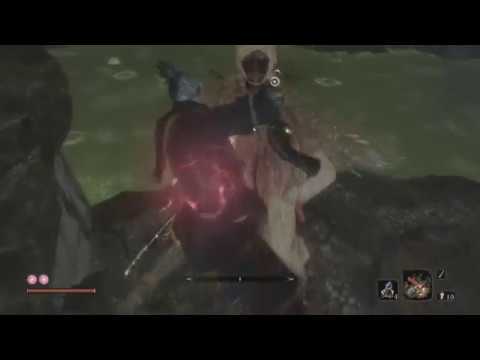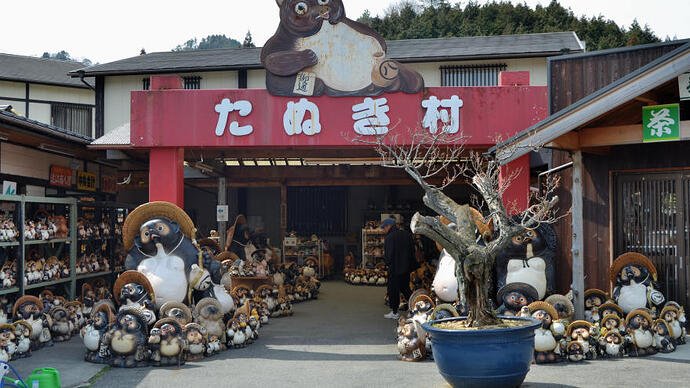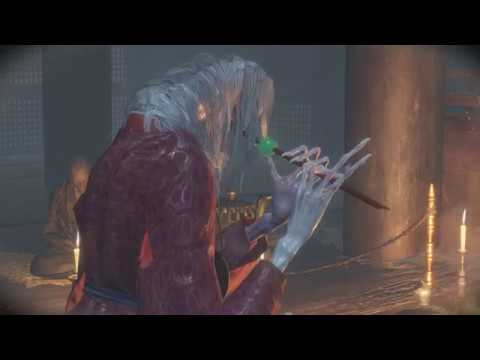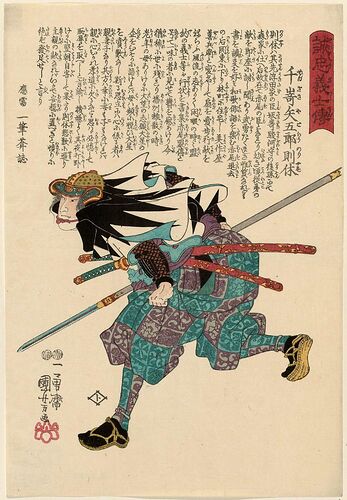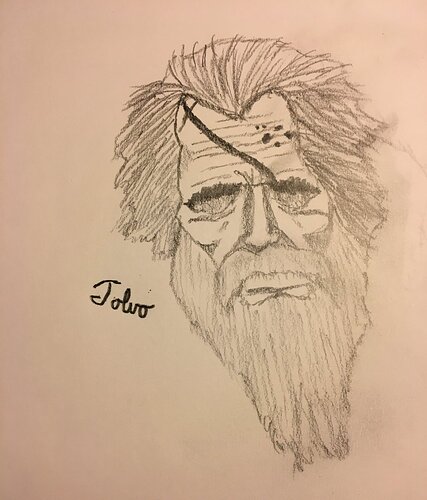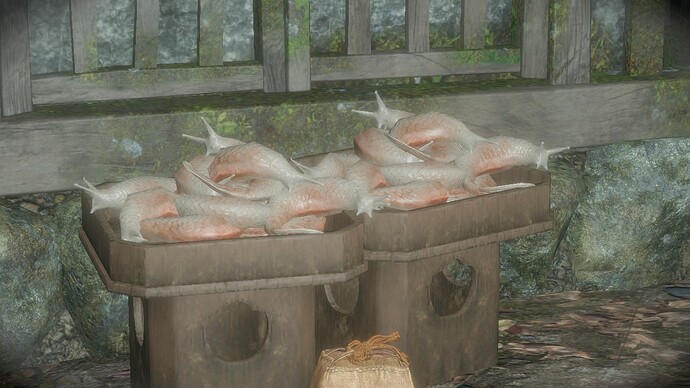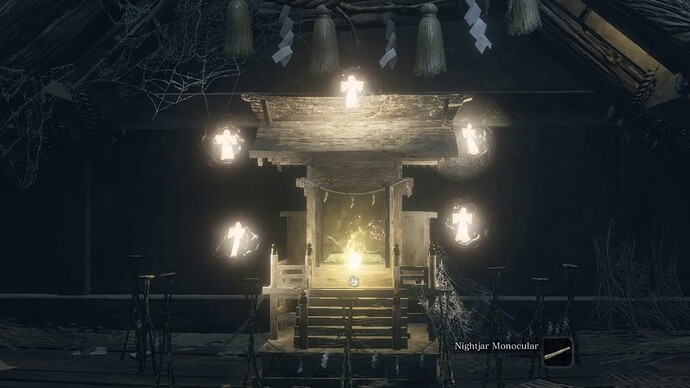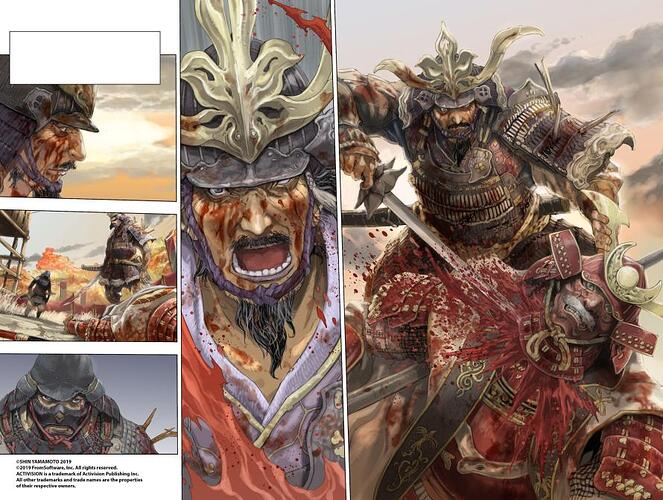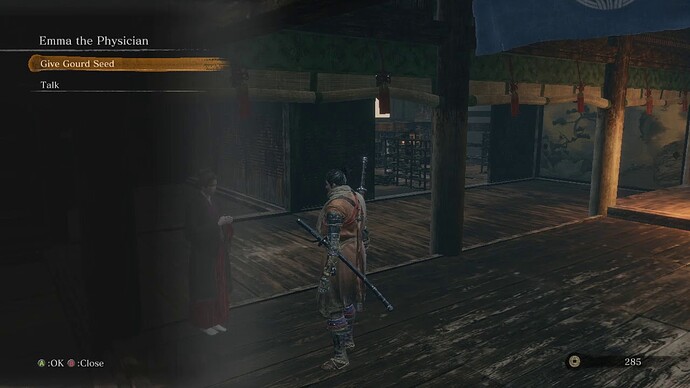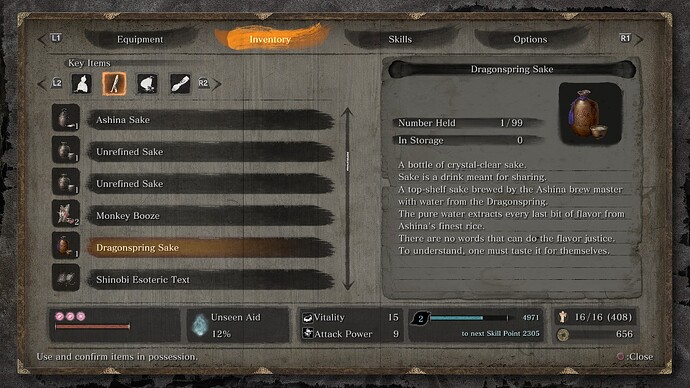Usually I just upload them public and post them in the thread when the time comes, no one really subs to my youtube so it’s not really a worry of people watching an episode early, and if they do mostly the thread is for additional info and videos.
Supplemental Content: Killing an Enemy Before Getting Your Sword
So I always wondered if it was possible, but just a neat thing I finally got to test, in Sekiro using Jump Kicks you can kill enemies before you get Kusabimaru(The Sword) in the prologue. Does not allow you to kill the miniboss since you can’t deathblow.
Let’s Play Sekiro: Shadows Die Twice - Episode 7 - Medicinal Beef
Warning for animal cruelty and flashing lights in this episode.
We are now on our way to Ashina Castle proper, before that we need to get past the beast guarding the gates of Ashina Castle. A strange creature, which shows the inhumanity of man and other such concepts that like to play upon contradictory terminology. From the Tengu we get a new skill tree that is incredibly useful for deflection, we meet an NPC, and get a small intro to the castle. Do not forget to kill the short guys with basket hats, they’re important if you don’t you’ll miss the Ashina Text.
Characters Introduced
Rice Oracle
NG+3 Charmless Demon Bell No Hit No Damage Fights Part
General Naomori Kawarada
General Tenzen Yamauchi
Chained Ogre
Gyoubu
Blazing Bull
Let’s Play Sekiro: Shadows Die Twice - Episode 8 - Forks in the Road
In this episode we get into Ashina Castle, but first we look at our new skill tree of the Ashina School which is a robust but small skill tree. We head to the Ashina Reservoir which is actually the area the prologue took place in. There we gain a spear prosthetic tool for stripping enemy armor, we also face one of the dread Seven Spears of Ashina. This boss trips up many as he can counter the Mikiri counter. Afterwards we take a trip into the well where this all started, fight the Lone Shadow there, meet an Ashina Samurai who is vexed by music, and enter the darkness that is the Ashina Depths yet we aren’t going to be completing that area yet.
Let’s Play Sekiro: Shadows Die Twice - Episode 9 - Iron Codified
Warning for rotting bodies, torture, bugs, body infestation, medical experimentation.
In this episode we return to Hirata and go about discovering more of what the hell is going on there. The estate is burning down and there we get a new Shinobi Prosthetic Tool the Mist Raven. It allows us to teleport when hit to avoid damage and get behind enemies. Our father also turns out to be dying and misquotes himself. We press on into the burning estate, then return to Ashina and enter another part of the Abandoned Dungeon and meet all the really disturbing stuff there.
Characters Introduced
Doujun
Kumano Jinzaemon
Maybe Owl changed the quote because he’s dying so there isn’t any point in Wolf obeying his father anymore? Were you able to check the japanese version?
Well in regards to that, vague spoilers ahead. Oh there is actually a reason for this. I am drawing attention to it so later when certain things happen people can go “Oh so that’s why that happened!”
Let’s Play Sekiro: Shadows Die Twice - Episode 10 - Ashina, Ash, Get It?
In this episode we get into Ashina Castle and find the Info Broker, after helping him out he heads back to the Dilapidated Temple to become one of the best merchants in the game. Through the rooftops we manage to get to the Antechamber and Dojo of Ashina Castle, which are just below the top of the Castle. Beneath the keep we find a new prosthetic tool, Sabimaru, my favorite tool in the game. It poisons enemies and makes many bosses quite a lot easier. Behind the Castle we discover the Old Grave which we’ll check out later, and the Serpent Shrine leaing to Sunken valley where we run into some monkeys. Seen here in this artwork based on the Hellboy comics(Note the art is excellent, I cannot verify the character of the artist but in either case I want to credit them).
https://twitter.com/INQWIRE_CH/status/1113529399389847553
Let’s Play Sekiro: Shadows Die Twice - Episode 11 - Thunderstruck
In the Dojo we face the Ashina Elite Jinsuke Saze. He is a boss that is there to teach you how to parry/deflect. He does quick double swings, a sort of lesser Ashina Cross. This attack causes chip damage on blocks but can be deflected with no chip damage. As well he will do quick little swipes or punches, the main meat of the fight is deflecting his double swings. Doing so will easily break his posture and get you deathblows. After defeating him you can learn Lightning Reversal. When an enemy uses lightning attacks you want to leap into the air and get hit by it, doing so will cause it to course through your body. You want to hit attack a moment after, sending the lightning away from you usually into an enemy. If you do it right it stuns the enemy and deals massive damage. If you’ve ever seen Avatar: The Last Airbender or Avatar: Legend of Korra the concept should be very familiar.
Afterwards we finally go to the top to face Ashina Genichiro. There we interrupt him trying to form a pact with Kuro, Kuro having blown the Reed Whistle calling for us. He refused Genichiro and Genichiro seeking to bring Ashina back to greatness saw no other way than through the blood of the Divine Heir and through killing Wolf who is also called Sekiro. It is here in a great battle we defeat Genichiro who is a boss that combines everything we’ve learned up to this point. However this doesn’t seem to be enough, as he sheds his armor and gives up his form as a mortal. Genichiro shows the teachings of his mentor Tomoe and unleashes upon us lightning, but with the power of Lightning Reversal he is no match for Sekiro. With him dead it means an end to the game and the LP thank you for joining-BUT WAIT! Genichiro is able to come back from death. It is revealed he is now an immortal after drinking the Rejuvenating Sediment. He escapes with plans to return. This is where the game really opens up allowing us to go down many paths. We are able to talk to Kuro and Emma and finally meet Isshin, who we actually may have met before. This marks the end of Sekiro’s early game, we are now in the Mid-game.
I apologize for how long this took, I’ve been busy with all sorts of raw data collection, guides, challenge videos, lore analysis, and behind the scenes work and ensuring I have proper save file copies and all sorts of things. The LP should continue at a steady pace. I actually plan to upload more tonight and work on posts, I have learned picture in picture in Sony Vegas so I can now put the actual statues and art on screen for what I’m talking about in regards to Buddhist figures and such matters. I hope this will help people visualize things more clearly.
Characters Introduced
Fujioka the Info Broker
Let’s Play Sekiro: Shadows Die Twice - Episode 12 - Mt Kongo May Be Worse Than Skull Island
WARNING: Very gross corpses, centipedes, bugs, vomit, body fluids, intestines, torture and death of children mentioned, medical experimentation mentioned.
In this episode we go to Mt Kongo, one of the three paths available to us. The three paths available are Mt Kongo/Senpou Temple, Ashina Depths/Mibu, and Sunken Valley/Gunfort. Senpou and Sunken Valley cannot be fully completed before beating Genichiro but they can be explored quite a bit before his defeat. Ashina Depths/Mibu can however be fully completed first. Personally I think it’s a good idea to do Sunken Valley last, it also probably has the hardest of the bosses available in these areas.
Mt Kongo is a horrible wretched place where the monks have strayed far from the path of the Buddha. They have broken the cycle of birth and death in their pursuit of immortality, and have been experimenting on children. The Jizo statues and pinwheels in this area are there to help the children move on to a better afterlife rather than be sent to a sort of hell. The concept being that they were killed before they could earn in life a better afterlife. It’s a very sad area, full of the corpses of many peasants. Some of the bandits here working with the Senpou monks are from Hirata and wear armor bearing the symbols of Hirata. Many of the statues in this location are of Buddhist deities. There are also Centipede Mercenaries here, who are really unexplained in the game. The monks appear to be performing a form of mummification and are becoming Sokushinbutsu. This is a form of living mummification via meditation. This may be how they are getting the centipedes to enter their bodies, as centipedes like to breed in hollows and the monks of Senpou are seemingly hollowing themselves out. Centipedes wrap around their eggs and young and the centipedes on the elders appear to be wrapping around and coiled within their lower abdomens. We meet Kotaro as well, a Taro Trooper and son of the man who was in the abandoned dungeon as a rotting zombie. Kotaro is confused and conflicted, and wants to help ease the spirits of the dead children and requires a pinwheel to help him know what to do. This is when we discover the Demon Bell as well, this is a Hard Mode in Sekiro. I normally play with it active, it increases enemy loot and buffs enemies. This can be turned off at any time by using the Bell Demon in your inventory. At the Demon Bell is a shinobi wall that leads back to Ashina Outskirts. You can actually get to this spot as soon as you beat Chained Ogre. We talk to Anayama and let him know the Ashina Samurai want more salt, expanding his inventory. Salt purification is very important in Shinto and is used to bury the dead, showing as well Ashina straying from the path and how displeased the spirits are such as the Headless and the creatures known as Shichimen, possibly a reference to Shichimen Gensai and certain Japanese spirits of the drowned.
Up at a bridge before the Temple proper, which may be based on To-Ji temple given it’s design and five story Pagoda, we run into the Armored Warrior. His name is not given but he is the father of Robert. Robert was a sickly boy from Europe with Robert’s Father(The Armored Warrior) paying for their travel to Japan. His goal was to use the powers of immortality to save his son. The Firecrackers prosthetic tool actually uses Robert’s Firecrackers which he sold to help pay for their trip. Robert unfortunately is likely dead, and we must defeat his father who even offers us a peaceful way out but Sekiro is resolute in getting the Red Mortal Blade from Senpou. He cannot be damaged through Vitality, and most be Posture Broken then kicked off the bridge. Which causes him to scream his son’s name in the famous line “Rooooobertooooooo!”/“Roobeeeeeeeeeert!”
Characters Introduced
Kotaro
Let’s Play Sekiro: Shadows Die Twice - Episode 13 - The Monkees
Warning for animal cruelty, death of children and child torture mentions, lots of centipedes.
In this episode we get ready to finish up Senpou. Strap in because it is a long one. We make our way up the temple grounds and past the many red bibbed statues of dead children killed before they could earn a good afterlife, these statues are meant to help them move on and to calm them along with the Pinwheels. The Pinwheels have kind of, well here’s the descriptions.
On a side path we deal with the Long-Arm Centipede Sen’un who is actually just a big dummy covered in blades.
After him we follow the paths lined with Jizo statues to ascend to the temple. When we reach the temple we are met with a statue of the deity Kannon along with many other statues.The Vajra are visible in many places and in Kannon’s hands sit Buddha. In this main hall if it is reached before defeating Genichiro an Elder of Senpou will be here. He is full of regrets(And centipedes) and if we have spoken to rice lady he will give us Holy Chapter Infested, which is actually a key item for one of the game’s endings we’ll be seeing later. Otherwise we’ll have to get it later.
On the table if Genichiro is beaten will be a bell with a Vajra, this is used to warn off and fight evil with the bell being viewed as containing a sort of void. Upon ringing it and praying Sekiro is sent to the Hall of Illusions.
Here we are met by a group of monkeys, the Folding Screen Monkeys. These Monkeys are actually manifestations of the children killed in the experiments done to create artificial Divine Children to make oaths of immortality with by the Senpou Monks. This is a stealth puzzle boss. In the area is a monk who is in this realm since it is as quiet and cut off from distraction as possible, this place is a realm between life and death.
There is a monkey in orange who alerts other monkeys, a monkey in purple with great vision, a green monkey with excellent hearing. The fourth folding screen is empty, but secretly contains a monkey. This is the invisible and seemingly drunk white monkey. Every monkey leaves footprints behind you can use to track them. the orange monkey you want to take out first, then any of the others can be killed next. It is possible to simply sprint at them and use shortcuts to get them. What you want to normally do is get them into environments that overload their senses and backstab them.
After defeating the monkeys we are sent to the Inner Sanctum. It is here we meet the Divine Child of the Rejuvenation. She is the only surviving child of the experiments and is a closely guarded secret of Senpou. This girl is the person who talked to us through the wall scroll, she holds the Red Mortal Blade. Those who unsheathe the blade die, against her warnings Sekiro wields the blade and dies. Thankfully as a Shadow he can die twice. He gets back up and now can use the blade, which is not a main weapon and instead is used for executions and two combat arts. The blade allows us to kill immortals.
The blade is named Gracious Gift of Tears, this is going to be very important. This is the blade required for Immortal Severance and for the making of the incense to reach the Divine Realm. The Divine Child is able to give us rice every now and then, it is a free healing item though she will get ill and require Persimmon be fed to her to regain her strength.
After we enter the cave of the Elders, a mysterious place full of Centipede Mercenaries and Jizo statues alongside seemingly dead or hibernating immortal Elders of Senpou. through this cave we are able to climb up to the five story pagoda, possibly based upon the Pagoda of To-Ji Temple.
Here are some photos of To-Ji Temple in Japan, which has links to Kyoto and Nijo Palace, which is likely the area this fictional Ashina is located around given a lot of what we’ll be looking in to later and the geography we’ve seen up to this point. Within the Pagoda we discover the Senpou Text allowing us to learn monk skills. these include punch and kick combos, leaps, and the ability to get more loot. We inform Kuro an Isshin of our success and both are glad, though we listen in on Isshin and learn there is another Mortal Blade, the Black Mortal Blade.
Characters Introduced
Green Senpou Elder
Illusory Hall Monk
Divine Child of Rejuvination
Correction!
In my notes I had some temple art mislabelled. Not all of the images were of To Ji Temple, some were of Kiyomizu dera Temple, specifically of the raised temple.
Let’s Play Sekiro: Shadows Die Twice - Episode 14 - Tanuki Voice: I’m In
Warning for loud gunshots.
In this episode we decide to not go down any main paths right away. Instead we check out the Old Grave area. This area is named for the Old Graves located there of Takeru and Tomoe. Tomoe being possibly an Okami and Takeru being a former Divine Heir who she served. This area is currently mostly empty save for Blackhat. I get into the localization and some translation issues in this game. Blackhat in English is called Badger. You may notice if you know even a little about Japanese and Japan’s folklore this is a bad translation. His name is Mujina in Japanese, which can mean badger but specifically means for him Tanuki, Yokai who are shapeshifters and trickesters. They even often wear straw hats and resemble him(And the Senpou assassins). The Ashigaru near him say the word Tanuki I noticed and wondered about his name and with the help of a friend Miyabi got a better translation. So his named in English would be better written as Blackhat Tanuki(Mujina being a bit of an archaic form of it as the game is set in 1620 roughly). From him we get the Loaded Umbrella which is a shield prosthetic that can block attacks.
After checking out the Old Graves we head to the Poison Pools. This area doesn’t have too much lore and is more of an in between, this is sort of Sekiro’s Blighttown. Now it should be mentioned you can jump and use a grappling hook so it really doesn’t matter that there’s poison. Here is one of the Snake Eyes tribes, they are descendants of the Okami and use lots of guns. Some of them carry guns made of many guns even.
Here is one of the Snake Eyes leaders, there are two of these minibosses in game. They’re powerful up close and at a range but are very weak to deflection. Many struggle do to her grapple which has incredible tracking. You can simply dodge to the side you need to either back up from her or deflect it. It is possible to get a backstab on her and you can make her walk into the poison and wait, eventually her health will reduce allowing you to just go up and kill her. This snake Eyes now has high poison resist though originally she didn’t. The other Snake Eyes is incredibly weak to poison on the other hand. We also get to see the corpse of a giant ape in a cavern where a boss will eventually show up, but not yet.
Characters Introduced
Blackhat Badger(Tanuki/Mujina)
Let’s Play Sekiro: Shadows Die Twice - Episode 15 - Hidden Mist Village
A bit of a simple episode. There’s very little to talk about as it’s mostly just going over some of the localization problems, a bit about Buddhism and some possible figures that are being referenced. We talk a little about Owl and Lady Butterfly and the butterflies of the Hidden Forest. For the article I was talking about in the video here is the link.
This area is shrouded in a mist that creates illusions. In this episode we have to fight a big sumo man likely based upon the Kabukimono.
These were often rogue samurai and bandits who dressed in outlandish ways and acted out of the ordinarily, famously Oda Nobunaga use to be considered of this group as a youth. After dealing with the sumo man known as the Glutton we face off against the toughest boss in the game, Mist Noble. There is no description worthy of that horror. Then after defeating him we clear the mist and move on to Mibu Village at the bottom of Ashina Depths so we can collect the Shelter Stone.
Currently for me youtube videos do not work on LP Zone so hopefully the above post has the youtube video for you.
So making this a separate post. But for some Sekiro art! I’ve been working on drawing some characters sometimes. I have drawn later things so they can’t be posted yet, but here’s one that can be. We’ve known him most of our life, it’s Owl, the Father of Wolf/Sekiro who adopted Wolf 20 years ago and raised him to be a Shinobi and to follow the Iron Code.
Let’s Play Sekiro: Shadows Die Twice - Episode 16 - Mibu Mure
Warning for undead, slugs, gross body fluids.
In this episode we get into Mibu Village. Mibu is a village at the bottom of Ashina Depths, it is where the headwater from Fountainhead flows to. This location has ancient water flowing into it that pools within Mibu Lake. The denizens of Mibu have become zombies. As we learn from Basket Boy the village High Priest has been feeding everyone Sake to make them thirsty, so that they would drink from the lake. Mibu Lake has impure water, this is again a concept in Shinto relating to flowing versus still water. This water that gathers seems to gift undeath, immortality, and centipedes. Those of Mibu have essentially had their minds and personalities lost due to this. Those of Senpou got centipedes, The Worm, of immortality. We’ll see more of it, but in Sekiro immortality is quite clearly a blight upon the land. Whether it’s the centipedes or the Dragonrot.
After Mibu Village’s zombies we meet a lone woman in a wicker hat playing the Shamisen, she’s standing past the Ashina Samurai Jinzaemon. He’s been obsessed with the sound and has followed it here.Upon talking to her we learn she is looking for Lord Sakuza, who no one can seem to find. After failing to answer her questions she attacks revealing she is a ghost known as O’rin of the Water. O’rin may be a reference to Lord Sazuka, or Oni/Devil Sakuza. His real name being Honda Shigetsugu, known as Honda Sakuzaemon. He served Tokugawa Ieyasu and was known as a fiend in battle, and had a daughter named O’sen. O is a common prefix for women’s names. Likely O’rin is a reference but I’m not sure if it’s any deeper than that. In either case she is a fast boss with brutal flurries. On NG difficulty she’s not very hard, it’s when you do Charmless No Hit No Damage that she is possibly the hardest fight in the game to overcome. O’rin is weak to poison, weak to Divine Confetti, and the Malcontent prosthetic on NG+ will stun her.
After defeating her she thanks us and visits Jinzaemon. When we arrive he gives us a Jizo Statue that references Lord Sakuza and then he dies happy.
Characters Introduced
Basket Boy
Hey, I’m enjoying this LP. I don’t have the time or inclination to dedicate to Getting Gud at fromsoft games, but I sure like the lore and design of them. So I appreciate the depth in your commentary.
Also why do 4/5ths of the characters in these games talk so (cough cough) slowly…
Thank you. ![]()
Fromsoft games love their awkward dialogue haha. I’m surprised this one doesn’t have most of the conversations end in a long drawn out creepy laugh like a lot of the others.
Also I’m sorry posting has been delayed, been working on NG+7 Charmless Demon Bell Glitchless speedruns and more No Hit No Damage videos. I’ll try to get a post up today. Sorry! ^_^;
Let’s Play Sekiro: Shadows Die Twice - Episode 17 - Deep Lore Dive
Yaobikuni from Blade of the Immortal, this is actually important but will be explored more later.
After defeating O’rin of the Water we move on to see the ending to Mibu. There we meet the Priest of Mibu who has feeding everyone Sake to get them to drink the corrupted water of the lake. Villagers have gathered outside his home which we have to enter through a Shinobi passage which is there for a mysterious reason. He is obsessed with the Water of the Palace. In his attic we find what is seemingly an old Sakura branch of the Everblossom tree and a prayer bead. Realizing he has nothing to really offer us we head to the next area.
Torii gates typically are a sign that you are leaving the normal and entering the mystical. These gates lead to a large open arena where a phantom spawns to face us. It is not an ordinary spirit but is a Boss, the Corrupted Monk.
The Corrupted Monk is a massive figure that delights in your suffering, she is large, powerful, and incredibly agile. Her health pool is quite large and she has only a single health bar. This is the Illusion Corrupted Monk, we’ll find out more about that later. She is weak to snap seeds and anti-illusion abilities. This fight can be grueling and her posture regeneration is tremendous. It is mostly a vitality fight until she is at about half health. Many of her combos are long and her attacks hit like a truck. It is best to get in only one or two hits as she will do sudden retreats with an attack than easily one shot players.
The Corrupted Monk wears a very easily identifiable mask, it is that of Hannya, a sort of Oni or vengeful woman demon/spirit. This is not entirely period accurate. Hannya may have existed as early as Sekiro but it is unclear if it really did during the periods Corrupted Monk likely is from, such as the Kamakura, Heian, and more possibilities. But it could be her mask is what ends up inspiring the mask in the world of Sekiro, or it has deeper meanings and history in Sekiro. Looking at her face though it is incredibly clearly this sort of Noh mask, and where Corrupted Monk is from is heavily influenced by Noh and various traditional arts of Japan.
After defeating the Corrupted Monk we are able to get the Shelter Stone, one of the objects we need for the Incense to reach the Divine Realm. She also gives us the Mibu Breathing ability, this opens the game up more. That’s right, this is Legend of Zelda now! Sekiro can dive underwater and breath underwater infinitely, we just got our Zora Tunic. With it we can explore many new though small areas and find lots of treasure, there is even 2(Technically 3 but the third isn’t really a boss) fights underwater. They’re mostly miserable.
Characters Introduced
Head Priest of Mibu
Let’s Play Sekiro: Shadows Die Twice - Episode 18 - Goodnight Sweet Prince
Warning for ritual suicide/execution in this episode.
This is a silent episode out of respect for a fallen friend.
We are going to be going over a lot of talking with Emma and Kuro, of tying up a few loose dialogue ends, learning about the Incense, more about Takeru the previous Divine Heir, we will also finally have a realization. Hanbei is our friend, our loyal sparring partner who laughs despite having no reason left to live. He is Hanbei the Immortal. He is unable to die. But he is also Hanbei the Infested, which is what the Senpou Monks were called. With our Immortal Blade we can finally give Hanbei the rest he desires from this world. After he learns of the blade he wishes for this, and says he will prepare and pray and say goodbye to the Sculptor(Sekijo). After he prepares for ritual execution, in a way that was hisotircally considerd honorable. Sekiro acts as his executioner, this was a traditional way for a warrior to die with honor that is different from the suicidal form. This form of execution was performed famously by Demon Hanzo on a son of Tokugawa Ieyasu to prove his devotion to Oda Nobunaga his master. Which ultimately was pointless, as the slander against Tokugawa’s son was totally fabricated and found out not long after the execution of his son and his mother.
In an upcoming Manga we will be learning more about Isshin’s Rebellion and the past of Hanbei and how he became Infested, as well as who he really is. There was a famous samurai named Hanbei of the Saito Clan, who was seen as an adviser to Hideyoshi. He is traditionally portrayed in media as very sickly and feminine and as having a sexual relationship with Hideyoshi, but I’m not aware of any sources that really support this.
Let’s Play Sekiro: Shadows Die Twice - Episode 19 - Hirata Was An Inside Job
Warning for lots of fire in this episode, slaughtered civilians.
We return to Hirata this episode to progress a bit more there. We are going to finish up things there for now until one of the ending paths, specifically Purification. Hirata as we see was not simply some bandits hitting a vulnerable settlement, this was carefully planned by someone. Judging by the fires and that they slaughtered everyone and barred people inside of burning buildings, the goal was to kill all witnesses. In Hirata the bandits are looting but there are darker figures here who have planned this whole thing behind the scenes.
Here we meet Nogami Gensai, a relative of Nogami inosuke and his mother. How they are related isn’t clear and adoption was very common. This is our Solaire of Astora basically. He will aid you in the coming battle if you talk to him. Up ahead is Juzou the Drunkard, a former Sumo who turned into a bandit lord. He is leading the bandits that have attacked Hirata, his fight finds him surrounded by allies. His clothing is reminiscent of Kabukimono, outlandish samurai and bandits and ronin who were eccentric. This massive man guards the entrance to the main manor which we need to enter to save Kuro. Nogami Gensai serves Ashina Isshin. You don’t get anything for keeping him alive but he is very helpful in this fight which is full of many enemies. Stealth and puppets make this fight a lot easier, just be wary Juzou hits very hard. After defeating him we find Inosuke and his mother inside. Inosuke gives us a snap seed and warns us of powerful illusion attacks ahead. We find a few secrets and look at some art of Cranes. After we head down the secret passage to find Kuro and fight to protect him from the figure bewitching him.
Here we face Lady Butterfly, who is literally pulling the strings. She is based on a classic Shinobi style in myth and media of the Shinobi using thin wire as traps that cut those who run into them, she uses them to appear to fly and walk on the air. Her focus is illusions, formerly she was Sekiro’s mentor. The first phase form of her is not the real her, despite her age Lady Butterfly is incredibly agile, she is one of the fastest bosses in the game and uses needle-like phantom Kunai, the ones that Anayama who survived Hirata was selling three years after Hirata. After entering her second phase she will begin to summon illusions that use the models of Mibu villagers. They can swarm and distract you while fighting her. Snap seeds will kill all of them around you but are limited. Spear Cleave can take out most around you, and your normal attacks will kill them. At the end of an illusion swarm she will snap her fingers causing them to raise up into butterflies that will home in on Sekiro. The butterflies she summons throughout phase 2 will home in on Sekiro and cannot be blocked or deflected, they must be dodged.
After killing her Sekiro prays, he then looks at the fire raging around and the many Buddhist statues and the statue of Fugen Bosatsu(I beleieve). While distracted he is stabbed through the heart from behind by someone who we do not get to see. In the rubble while dying, Sekiro witnesses Kuro pushing aside debris to reach him. Kuro is amazed at his loyalty and offers his blood to bring him back. This is when Sekiro actually first gained the ability to revive and became linked fully to the Divine Heir of the Dragon’s Heritage.
Characters Introduced
Lady Butterfly
Nogami Gensai
Let’s Play Sekiro: Shadows Die Twice - Episode 20 - Sake Valley
Warning for lots of alcohol use, creepy ghosts and noises, lots of gunshots and bright flashes.
In this episode it is time to finish up the Sake dialogue, this will tell us a lot about the pasts of Emma, Sculptor, and Isshin. We learn more about Dougen, his relationship with the three and his role as Emma’s second adopted father. All three were tightly linked, with Sculptor formerly being a servant of Isshin who was the person that originally cut off his arm to prevent him from becoming a Shura. Dougen was the one who sculpted the original arm for Sekijo(The Sculptor). Emma was childhood friends with Genichiro, and was saved by the Sculptor who she called Orangutan. Isshin, Emma, Sculptor, and Dougen, were all friends and like family. But more than that, friends to them were also Lady Butterfly, Owl, and even Gyoubu.
https://twitter.com/sinzui0301/status/1123947049957957633
Fan Art of what Tomoe may have looked like with her master Takeru(Though personally Takeru sounds like an adult in his notes to me).
Isshin also talks of his fight with Tomoe, the mentor to Genichiro and likely Okami. She had eyes like an ocean and was beautiful, and Isshin considered her one of the most dangerous if not the most dangerous person she had ever faced in battle. Afterwards we head to the Serpent Shrine and Sunken Valley, there we meet the Tengu(Who is secretly Isshin). He gives us the Mushin Text, you can only get this if you have the final technique of a skill tree. I had Ashina Cross so I got this here. If you don’t get it from Tengu you may miss it until the end of the game, or even NG+. Mushin’s tree is full of super forms of final Combat Arts.
In the Sunken Valley we see the descendants of the Okami, the Snake Eyes. We met them in the Poison Pools before and their gunners are around Ashina Castle seemingly hired to defend it. With our newfound ability to dive underwater we find a secret ice cave and fight a Headless, to get a Spiritfall from it. I show off the strategy in the video, strafe to its back and hit it. Use Divine Confetti for extra damage, and with Divine Confetti you can deflect Headless and take no damage or terror build up.
